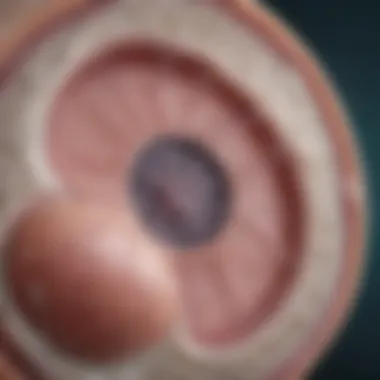Stem Cells and Their Role in Osteoarthritis Treatment


Intro
Osteoarthritis, a common degenerative joint disease, leads to significant pain and reduced mobility for millions worldwide. Current treatments often focus on managing symptoms rather than addressing the underlying cause. This is where stem cell therapy emerges as a promising alternative. Stem cells have unique properties that allow them to repair and regenerate damaged tissues. Their potential application in treating osteoarthritis could revolutionize how we understand and tackle joint diseases.
The advancements in regenerative medicine have placed stem cells at the forefront of osteoarthritis treatment strategies. As research continues to evolve, many inquiries arise: How do stem cells interact with damaged joint tissues? What have clinical trials revealed about their efficacy? And what ethical considerations should be taken into account? This article provides a comprehensive examination of these aspects, presenting insights into how stem cell therapy could reshape osteoarthritis management.
Methodology
Overview of research methods used
The investigation into stem cell therapy for osteoarthritis involves multiple research approaches. Many studies adopt a mixed methods design, combining quantitative and qualitative data. This allows researchers to gauge both the effectiveness of treatments and the patients’ subjective experiences.
Data collection techniques
Data collection typically includes:
- Clinical Trials: Evaluations conducted on groups of patients receiving stem cell injections to observe outcomes.
- Patient Surveys: Questionnaires designed to assess quality of life and pain relief levels.
- Laboratory Studies: Preclinical research that examines how stem cells behave in vitro before moving into human trials.
- Longitudinal Studies: Research monitoring patients over extended periods to track the long-term effectiveness of therapies.
Future Directions
Upcoming trends in research
The ongoing exploration of stem cells in osteoarthritis opens doors to exciting trends. These include advancements in gene editing and personalized medicine. Researchers are investigating how to enhance stem cell efficacy by modifying their biological environment. Moreover, the focus is shifting toward identifying optimal stem cell types for different stages of osteoarthritis.
Areas requiring further investigation
Despite promising results, several gaps remain in current knowledge. More comprehensive studies are necessary to understand:
- The long-term effects of stem cell therapy on joint health.
- The most effective methods for stem cell administration.
- The role of stem cell therapy compared to conventional treatments.
In summary, the research surrounding stem cells offers a beacon of hope for osteoarthritis management. As the field evolves, continued investigation will be crucial to unlocking the full potential of these therapies.
Understanding Osteoarthritis
Osteoarthritis is a widely prevalent degenerative joint disease that poses significant challenges to millions worldwide. Understanding osteoarthritis is crucial for several reasons. First, it lays the groundwork for exploring advanced treatment options, particularly the role of stem cells, which may offer new hope for patients. Second, comprehending the disease assists researchers and practitioners in identifying potential areas where stem cell therapies could intervene effectively. Additionally, a detailed overview of osteoarthritis helps in designing better clinical trials and optimizing treatment protocols.
Definition and Characteristics
Osteoarthritis is primarily a condition marked by the breakdown of cartilage in the joints. Cartilage serves as a cushioning material between bones, and its deterioration can lead to pain, swelling, and decreased mobility. The disease typically affects weight-bearing joints such as the knees, hips, and spine but can occur in any joint. Key characteristics of osteoarthritis include changes in joint structure, including osteophyte formation, subchondral bone remodeling, and the presence of effusions.
The progression of osteoarthritis can differ widely among individuals. Some may have only mild discomfort, while others suffer from severe pain that affects day-to-day activities. Understanding these variations is essential when evaluating the effectiveness of any treatment, including stem cell therapies.
Common Causes and Risk Factors
The development of osteoarthritis is linked to multiple factors. Understanding these causes and risk factors is vital for both prevention and treatment strategies. Some common contributors include:
- Age: The risk of developing osteoarthritis increases as individuals grow older due to cumulative wear and tear on the joints.
- Genetics: Family history can play a significant role, indicating a hereditary component in some cases.
- Obesity: Excess body weight contributes to increased stress on weight-bearing joints, leading to cartilage breakdown.
- Joint Injuries: Past injuries from sports or accidents may predispose individuals to osteoarthritis later in life.
- Overuse: Repetitive strain on joints, especially in certain occupations or athletic pursuits, can accelerate the progression of osteoarthritis.
Recognizing these causal elements enables healthcare professionals to recommend lifestyle modifications that might reduce the risk of disease onset or slow its progression.
Symptoms and Diagnosis
Symptoms of osteoarthritis can vary, but common signs include joint pain, stiffness, swelling, and a decreased range of motion. Pain usually worsens with activity and improves with rest. Morning stiffness may also be notable, typically lasting for a short period.


Diagnosis of osteoarthritis primarily involves clinical evaluation. Physicians typically assess medical history, conduct physical examinations, and may request imaging studies such as X-rays or MRI scans to evaluate joint condition and rule out other potential causes of pain.
Understanding the symptoms and diagnostic criteria is essential for accurate evaluation and timely management, which may include considering innovative treatment options like stem cell therapy.
Stem Cell Biology
Understanding stem cell biology is essential in the context of treating osteoarthritis because it lays the foundation for how these cells can be harnessed to repair damaged joint tissues. Stem cells possess unique properties such as self-renewal and the ability to differentiate into various cell types. These characteristics make them a key player in regenerative medicine, particularly in conditions like osteoarthritis, where joint tissue undergoes significant degeneration.
Types of Stem Cells
Embryonic Stem Cells
Embryonic stem cells are derived from early-stage embryos. They are known for their pluripotent nature, meaning they can differentiate into any cell type in the body. This flexibility allows them to contribute effectively to repairing damaged cartilage in osteoarthritis. Their capability to proliferate indefinitely makes them a valuable resource for research and potential therapies. However, the use of embryonic stem cells raises ethical concerns regarding the source of these cells, which can limit their application in clinical settings.
Adult Stem Cells
Adult stem cells, also known as somatic stem cells, are found in various tissues. They primarily help in repair and maintenance of the tissues in which they reside. One key characteristic of adult stem cells is their multipotency, which allows them to differentiate into a limited range of cell types relevant to their tissue. For example, mesenchymal stem cells from bone marrow can become cartilage cells. They are popular in osteoarthritis treatment because they can be harvested from the patient, leading to fewer rejection risks. However, the potential for limited growth and differentiation capabilities doesn't make them as versatile as embryonic cells.
Induced Pluripotent Stem Cells
Induced pluripotent stem cells (iPSCs) are generated by reprogramming adult somatic cells. This innovative approach enables these cells to regain pluripotency, similar to embryonic stem cells. One unique feature of iPSCs is their ability to be generated from a patient’s own cells, which minimizes ethical concerns and rejection risks. They hold significant promise for osteoarthritis therapy due to their potential for extensive proliferation and differentiation. Nevertheless, there are challenges related to the efficiency of reprogramming and concerns about possible genetic abnormalities in iPSCs.
Mechanisms of Action
Tissue Regeneration
Tissue regeneration is central to the therapeutic role of stem cells in osteoarthritis. The ability of stem cells to generate new cartilage tissue is crucial for restoring joint function and reducing pain. One of the primary benefits of tissue regeneration is its potential to heal the underlying causes of osteoarthritis rather than just addressing symptoms. However, the complexity of signaling pathways involved in regeneration may pose challenges in achieving consistent results across different patients.
Inflammation Modulation
Stem cells can modulate inflammation, a key component in osteoarthritis pathology. By secreting anti-inflammatory factors, stem cells help alleviate the inflammatory response that contributes to pain and joint degeneration. This mechanism can provide dual benefits: reducing symptoms and potentially halting disease progression. Despite their promising role, the long-term impact of inflammation modulation by stem cells in joint diseases is still under investigation.
Cellular Communication and Signaling
Cellular communication and signaling represent another important mechanism for stem cells. Through various signaling pathways, stem cells can interact with the local environment and other cell types. This communication is vital for coordinating repair processes and influencing the behavior of surrounding cells. The unique aspect of this mechanism is its ability to create an environment conducive to healing, which is essential in managing osteoarthritis. However, variability in signaling responses among patients could limit the efficacy of stem cell therapies.
Stem Cells in Osteoarthritis Treatment
The use of stem cells in osteoarthritis treatment represents a promising area of research and application. Osteoarthritis causes chronic pain and joint dysfunction, leading to significant impairment in quality of life. Traditional treatments often focus on symptom management rather than addressing the underlying causes. This is where stem cells can play a vital role, by potentially repairing damaged tissues and restoring function.
Stem cell therapies are of great interest due to their unique ability to regenerate tissue. The dynamic nature of stem cells allows them to either differentiate into cartilage cells or release factors that promote healing. As researchers explore these mechanisms, it becomes increasingly clear that therapies leveraging stem cells can offer advantages over conventional treatments. The focus shift to regenerative approaches marks a significant paradigm change in osteoarthritis management.
Current Research Landscape
Research into stem cell therapy for osteoarthritis is rapidly evolving. Many clinical studies focus on understanding the mechanisms of action and the most effective administration routes. Among the key areas currently explored are the optimal cell types for therapy, dosage, and treatment timing.
Recent studies demonstrate that stem cells can significantly reduce pain and improve joint function in osteoarthritis patients. However, reproducibility and long-term outcomes remain areas of concern, necessitating further investigations in larger cohorts and diverse populations. The scientific community is working to establish clear guidelines for clinical practices and regulatory compliance, as well as to identify biomarkers that can predict treatment responses particular to individual patients.
Clinical Applications
Autologous Stem Cell Therapy
Autologous stem cell therapy involves the use of a patient's own stem cells, sourced most commonly from bone marrow or adipose tissue. This therapy is favored due to its reduced risk of immune rejection and the ability to tailor treatments to individual patient profiles. One key characteristic of this approach is the minimally invasive collection process.
The benefits of autologous therapy include a lower complication rate and often quicker recovery times. However, there are challenges, such as variability in stem cell yield and quality, depending on the patient's age and health. This variability raises questions about the consistency of treatment outcomes.


Allogeneic Stem Cell Therapy
Allogeneic stem cell therapy utilizes stem cells from a donor. This approach expands the available cell types and can provide immediate treatment options for patients who may not have viable cells. A notable benefit of allogeneic therapy is the potential for a more standardized product, leading to consistent results across patient populations.
Nonetheless, this method raises ethical concerns regarding donor consent, as well as risks for immune response or disease transmission. Ensuring safety and efficacy remains crucial, demanding thorough screening and ethical oversight in the collection and use of donor stem cells.
Combination Treatments
Combining stem cell therapy with traditional interventions such as physical therapy or medications presents a novel approach in treating osteoarthritis. The aim is to enhance overall effectiveness by addressing multiple aspects of the condition. One key characteristic of combination treatments is the potential synergy between different modalities, which can provide more comprehensive outcomes for patients.
The advantages of this strategy include improved pain management and faster recovery periods, addressing both the biochemical and physical aspects of the disease. However, careful consideration is needed to assess the combined effects and manage the risks associated with multiple interventions. Sufficient clinical evidence is required to establish the most beneficial combinations, ensuring patient safety and optimal results.
"Stem cell therapy is a beacon of hope for many suffering from osteoarthritis, offering potential solutions that target the root of the problem rather than merely alleviating symptoms."
As the research landscape develops, understanding the multifaceted role of stem cells in osteoarthritis treatment will become increasingly relevant. Engaging in this exploration helps clarify how these innovative therapies can change patient outcomes.
Evaluating Effectiveness
Evaluating the effectiveness of stem cell therapy in treating osteoarthritis is essential. This evaluation assesses how well these therapies can relieve symptoms, improve function, and enhance the quality of life for patients. Effectiveness measures can guide clinical practices and research directions, informing decisions for a personalized approach. There are various elements to consider, including clinical trials, comparative studies, and patient outcomes.
Recent Clinical Trials
Recent clinical trials offer new insights into the role of stem cells in osteoarthritis treatment. These trials evaluate different types of stem cells, dosing regimens, and delivery methods. For instance, studies focusing on autologous stem cell therapy are markedly notable. They utilize patients' own cells, minimizing the risk of rejection. The outcomes of these trials can show improvements in pain reduction and functionality. Continuous monitoring and data analysis from these trials will refine protocols, thus optimizing future treatments.
Comparative Studies
Stem Cells vs. Traditional Therapies
A comparative study between stem cell therapies and traditional treatments presents vital information. Traditional options like corticosteroids and non-steroidal anti-inflammatory drugs (NSAIDs) tend to mask symptoms rather than providing long-term relief. In contrast, stem cell therapies address the root cause of the damage, promoting healing and regeneration of the joint tissues. The unique characteristic of stem cells is their ability to differentiate into various cell types, which is not achievable with standard medications.
However, it's essential to recognize that stem cell treatments may not work for every patient. Some variability in results can arise from individual responses to treatment. Thus, personalization remains critical.
Long-Term Outcomes
Long-term outcomes are another important aspect to consider. Assessing the durable effects of stem cell therapy is crucial for comprehending its overall efficacy. Studies suggest that patients may experience sustained improvements after stem cell administration, surpassing the temporary relief often associated with traditional therapies.
One unique feature of examining long-term outcomes is the focus on improved joint function. Monitoring this allows for a better understanding of recovery timelines and rehabilitation needs. Nevertheless, more research is required to establish definitive long-term effects and the optimal timing for such treatments.
Evaluating effectiveness is a definitive step in revolutionizing osteoarthritis treatment through stem cells. By analyzing trials and comparative studies, stakeholders can gain valuable insights, shaping the future of regenerative medicine.
Challenges and Considerations
The use of stem cells for osteoarthritis treatment invites various challenges which are significant to consider. These challenges can impact the effectiveness of treatments and the overall landscape of regenerative medicine. Understanding them is essential for stakeholders involved in research, clinical practice, and patient care.
Ethical and Regulatory Aspects
Stem cell therapy raises complex ethical and regulatory concerns. Different types of stem cells, especially embryonic stem cells, may face restrictions based on their source and the methods used in their extraction. It is important for researchers and clinicians to adhere to ethical guidelines and regulations that govern stem cell research and therapy. Such guidelines are necessary to ensure that patient rights are respected and that the procedures do not involve unnecessary harm. Regulatory bodies like the Food and Drug Administration (FDA) have established frameworks to assess the safety and efficacy of stem cell treatments. Adhering to these regulations helps build public trust and encourages funding for further research.
Potential Risks and Limitations
Stem cell therapy can enhance treatment options, but it is not without potential risks and limitations. Understanding these aspects is crucial for informing patients and healthcare providers.
Adverse Effects


Adverse effects are an important concern when considering stem cell treatments. Some risks may include infection at the injection site, immune reactions, or even tumor formation. It is critical to communicate these risks to patients comprehensively, helping them make informed choices. While many studies report positive outcomes from stem cell therapies, understanding the potential for adverse effects creates a more balanced view. Practitioners must monitor patients closely following treatment to detect and manage any possible complications that arise.
Variability in Patient Responses
Variability in patient responses to stem cell therapies is also a central consideration. Factors such as age, overall health, and the specific characteristics of the osteoarthritis may influence outcomes. This variability can complicate the efforts to standardize treatments and predict patient responses. It becomes essential to tailor treatment plans to individual patients to improve efficacy. Patients may respond differently to the same therapy, leading to inconsistencies in treatment success. Understanding this variability helps practitioners optimize treatment protocols, ensuring they are more effective for an array of patients.
"Addressing the challenges and considerations around stem cell therapy is vital for creating a sustainable approach to osteoarthritis treatment, ensuring both safety and effectiveness."
As research progresses, continuously evaluating these challenges will play a critical role in shaping future applications of stem cells in managing osteoarthritis. This will inform new strategies, enhance regulatory frameworks, and ultimately, improve patient outcomes.
Future Directions
The exploration of stem cell therapy in the context of osteoarthritis opens a multitude of pathways for future directions. As researchers continue to gain insights into the mechanisms by which stem cells contribute to tissue repair and regeneration, various innovative methodologies are emerging. The importance of focusing on future directions lies in the potential to refine current therapies, enhance efficacy, and broaden accessibility for patients suffering from osteoarthritis. Advances in understanding stem cell biology will empower healthcare professionals to develop more targeted treatments, ultimately improving quality of life for those affected by this degenerative disease.
Innovative Approaches
Innovative approaches are key for the progress in stem cell applications for osteoarthritis. Investigators are looking beyond traditional therapies and considering novel strategies that can optimize stem cell use. These approaches often involve combining stem cell therapy with other modalities to amplify therapeutic effects. For example, the integration of gene therapy with stem cells can enhance their regenerative capabilities.
Such innovative strategies offer the advantage of personalized medicine, allowing treatments to be tailored for individual patient needs based on specific pathology.
Integrating Technology
Bioprinting and Tissue Engineering
Bioprinting and tissue engineering represent significant advancements in regenerative medicine for osteoarthritis. This technology enables the creation of complex tissue structures that mimic native cartilage. The key characteristic of bioprinting is its ability to layer living cells and biomaterials precisely. It offers a beneficial choice for osteoarthritis treatment as it enhances cellular organization, supporting natural tissue formation.
The unique feature of bioprinting lies in its adaptability to create implants tailored for individual anatomical characteristics. Although bioprinting might involve longer development times and higher costs, its advantages include reduced surgical risks and potentially improved healing responses. The integration of bioprinted constructs with existing therapies indicates a promising future in joint restoration and repair.
Gene Editing Techniques
Gene editing techniques, such as CRISPR-Cas9, are also emerging as powerful tools in addressing osteoarthritis. These techniques allow precise modifications in stem cells to enhance their effectiveness. A key characteristic of gene editing is its ability to target specific genes implicated in the disease process. This makes it a popular choice in the context of regenerative medicine.
The unique aspect of gene editing techniques is their capacity to potentially correct molecular defects that lead to joint degeneration. While the advantages include tailored therapies with specific targeted results, there are also considerations of ethical implications and technical challenges. Balancing these factors will be essential as the field progresses.
In summary, the future of stem cell therapy in osteoarthritis is promising, driven by innovative approaches and the integration of advanced technologies such as bioprinting and gene editing. Each of these advancements offers new possibilities and requires careful evaluation to align scientific possibilities with clinical applications.
Epilogue
In this article, we explore the profound implications of stem cell therapy in treating osteoarthritis. This degenerative condition not only affects countless individuals but also poses significant challenges for the current treatment options. The conclusion synthesizes the insights gained throughout our discussion and highlights the vital role stem cells may serve in mitigating these challenges.
Summary of Key Findings
Stem cell therapy shows promise for osteoarthritis treatment through various mechanisms, including tissue regeneration and inflammation modulation. Key findings from recent studies indicate that:
- Autologous stem cell therapy involves using a patient’s own cells, which may reduce the risk of rejection and improve outcomes.
- Allogeneic stem cell therapy provides a different approach, utilizing cells from donors, offering immediate availability and potential scalability.
- Trials demonstrate that stem cell treatments can lead to significant improvements in symptoms and functionality, with some patients experiencing reduced pain and enhanced mobility.
These findings suggest that stem cell therapy could represent a transformative intervention—and one that moves beyond the limitations of current conventional treatments.
Implications for Patients and Practitioners
For patients, the introduction of stem cell therapy may herald a new era of hope in managing osteoarthritis. The benefits include:
- Potential for repair: Unlike traditional treatments, which primarily aim at symptom relief, stem cell therapy targets the underlying degradation of cartilage.
- Improved quality of life: Many patients report enhanced function and reduced pain, which leads to greater engagement in daily activities.
- Need for informed consent and understanding: As with any emerging treatment, awareness about the potential risks and benefits is crucial.
For practitioners, this advancement necessitates a shift in focus. Specifically, they must:
- Stay updated on the evolving research landscape to provide evidence-based recommendations.
- Consider ethical implications when discussing treatment options, particularly around donor cells and informed consent.
- Evaluate patient responses carefully to tailor interventions effectively as individual reactions to treatment can vary significantly.
"Understanding the evolving role of stem cells in osteoarthritis treatment is critical for both patients and healthcare providers, as it opens new pathways for effective management of a prevalent condition."
In summary, as research progresses, the integration of stem cell therapy into clinical practice may not only offer new hope to patients suffering from osteoarthritis but also redefine treatment paradigms in regenerative medicine.







